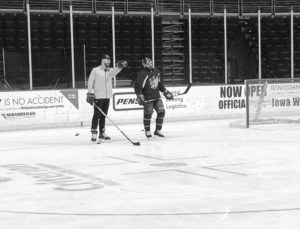KGB VOL 14: How to take full advantage of the off season
I speak ad nauseum about mastering the basics. In my role as a performance consultant, I can have a conversation about this several times each day. Such repetition can be monotonous and, for some people, it is not their cup of tea. I find myself thriving in this situation because instead of viewing it as boring repetition, I view it as a helpful routine. I tend to be unwavering in my approach. Much like other coaches, my work with players generally doesn’t move forward until each step in the process has been firmly established and then owned.
When the basics are locked down, we can start to think beyond the routine and start to chase down the shiny bells and whistles that lead to excellence. High-level performance can involve a variety of approaches. Most of the time, the end result is the only aspect of the process that gets glorified. But, as most of us know, the devil is in the details. For decades, players and coaches have been known to have unique pre-game rituals that mentally and physically prepare them for competition. These rituals were established by mindfully searching for the perfect grind after years of wins and losses, both literal and figurative. In the off-season, these pre-game rituals might get put to bed for a while, but the emphasis on the day-to-day grind remains true.
As another season comes to an end and it comes time to assess where to put in the work this off-season, be intentional in your approach. Look at your development from all sides and make sure to take a holistic view of your performance. Ask yourself, “What can I learn about myself this off-season to improve future performance?” This is the time for the “notice and name” strategy. Notice the improvement that needs to be made, name the approach you will take to improvement. On the other side of the coin, and just as important, notice what you do well and name the things you worked on to achieve these skills. Sometimes, however, this approach can become overwhelming.
If we have several things that we think need to be managed but only have limited time, we need to create a Tournament of Competing Demands. This strategy requires that you create a “tournament bracket” that outlines all your off-season wants and needs. Thoughtfully compare these items and see which ones rise to the top of the priority list. High-priority items will get managed first, moderate priorities can be sprinkled in to round out your efforts and other, lower-impact priorities will need to be tabled for the future.
So, what should you prioritize? What should become part of your ritual?
Start with active listening: As a player, when you speak with your skills coach or during your exit meetings with your head coach, listen carefully to what your coaches might be saying about your game. If you are a coach and have questions or engage in some open dialogue with your players, the same rules should apply. Active listening is not easy and may take some practice, but it is a vital extension of good communication. At the core of it, active listening is listening objectively, without emotion. We are simply listening and collecting data. What positives are present? What negatives are present? We are neither agreeing or disagreeing with what is being said, but listening with an ear for what the real message is. This is the time to ask for clarification on certain aspects of the conversation. One simple tool of active listening is to “mirror” your partner in the conversation by simply repeating the last thing they say. This is a technique that I learned from FBI hostage negotiator Chris Voss. It is a simple and powerful way to get someone to expand on their statement and to get to the real intent of the message.
Here are some thing a coach might say:
- “You need to be quicker on loose pucks.” In this case, an “active listener” realizes that the coach wants quickness, to win loose pucks. You begin to realize that there are many things that go into the term “quickness.” Is it a pure speed thing (technical) or is it maybe an anticipation (tactical) issue? This is where a simple “mirror” may provide more clarification. So, the conversation might continue:
Player: “Quicker on loose pucks?”
Coach: “Yes, I want you to anticipate the play more and be ready to jump on this puck.”
OR
Coach: “Yes, I think you need to work on your foot speed in the off-season so you are a little quicker on your first three or four steps.”
This simple active listening technique of mirroring allows the other party to explain their perspective to you. Once you as the listener can understand the other party’s perspective, it makes it much easier to engage in future conversations, but more importantly it allows the player to know where to focus their efforts in the off-season. This is a conversation skill and not something that comes naturally to most of us.
Here’s something a player might say:
- “I want more time on the power play.” In this scenario, a coach who is an active listener will figure out that the player wants a change, wants more intensity, wants to get in on some different action on the ice. There are so many factors that go into building a line-up and creating a special teams unit which is not something the average young player would be aware of. The player may not appreciate how you put these pieces together. Understanding their perspective may give you an opportunity to learn something about this player. A simple clarification question might allow for more insight.
Coach: “You want more powerplay time?”
Player: “Yeah, I think I can help on special teams because I can win loose pucks in the corner and help us maintain puck possession.”
In this example of active listening, the coach now knows what this player feels they can contribute and what skills they possess to help the team. The coach still has the last say in line-up and team culture, but knowing where your players stand is a valuable resource.
Once a conversation has been had and both parties are clear on the points that were communicated, we look for actionable performance solutions. Having a clear framework is helpful when balancing various performance qualities.
Here’s a coaching framework to consider:

BUCKETS OF IMPROVEMENT
- mental: focusing on response to high pressure situations, being a good teammate, etc.
- physical: enhancing strength, size, speed, etc.
- technical: improving skating, puck skills, shooting, etc.
- tactical: increasing situational awareness, understanding of team structure, etc.
Consider targeting performance solutions in one or more of these buckets. This will give direction to the player and empower them to find solutions. Maybe you like a different grouping. No worries; just find a framework that works for you and allows you to deliver your message consistently and clearly.
In terms of player focus, we want to break our framework down a little further. First, there are baseline, day-to-day considerations: Are there any potential solutions for players looking to take their play up a notch in these crucial buckets?
- Sleep health: Do you consistently get 7+ hours each night?
- Nutrition: Do you eat enough food? Do you eat enough of the right foods?
- Joint/tissue health: Do you have a plan to regularly check in on your joint and soft-tissue health?
- Recovery: Are you recovering from game to game, practice to practice?
- Stress management: How do you manage various stressors like your sport, your school commitments, your social life, and your family?
Next, we refine consideration related to character development and injury history, aspects of the game that are a little higher on the sophistication ladder. After your baseline concerns are addressed, a quality player must give consideration to personal development, reflecting on and employing strategies to improve work ethic/character. Don’t forget to recognize any limitations or impacts of injury from your previous season. Previous history in injury is one of the biggest predictors of future injury.
Beyond this, every player must constantly monitor physical performance considerations like strength and body composition, anaerobic power/tolerance, and aerobic power and endurance.
In the sport of hockey, there are always technical considerations that must stay in the front of your mind like skating speed, quickness, puck skills and achieving that laser-focused shot. Add to that the tactical considerations of the sport like general hockey game sense and positional awareness, and every player has plenty to chew on as the off-season develops and there is time to really focus on overall improvement.In the next installment of KGB, we will discuss how to organize your approach. We will use the concept of Competing Demands to help keep your eye on the prize and avoid common distractions.
